
A few days spent in South Thailand and I feel that I’ve spent my entire lifetime there. That is how inspiring travelling can be. It can change moments, perspectives, individuals and lives. Co-living in the ecosystem and incorporating that in daily lives – that’s what the farmers or the fishermen of this island has done. They have embraced the environment they live in. And are proud to introduce their culture and lives to the tourists. Baan Ma-Yhing Restaurant, situated by the fish farms, on a canal shooting out of the Krabi river – where the fresh fish is caught and cooked and served – all in a span of 45 minutes – is one such fresh culinary experience not to be missed. I’ve ransacked it’s location on Google Map and have frantically searched the net for their website, if at all it exists. I genuinely feel that this small restaurant is worth more than just a visit. It might seem very complicated but in effect there’s only one main road running through the island and there are only a few restaurants located in the fishermen’s village along the canal district. The Google translator literally translates the restaurant’s website, hence please apply your own IQ while deciphering that translation! You might have to read some weird English as Home straight Ma (grandmother) our which probably means House (Baan) of the Grandmother (ma-Yhing). Or the tagline reads as Cages as other seafood which probably means freshly caught Seafood!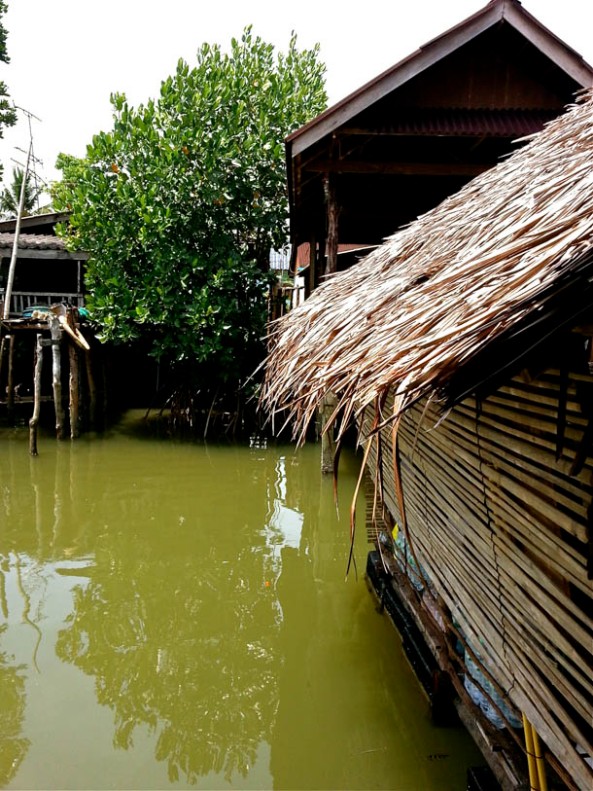
Koh Klang is a small fishing island on the Andaman Sea and is covered by thousands of acres of mangrove forest. Koh means island, Klang means middle and Koh Klang is situated in the middle, just at the mouth of the Krabi river as it opens up into the Andaman Seas. Located in the Krabi province on the west coast of southern Thailand, this is an idyllic island with smiling locals overwhelming the tourists in an inspirational way. The Baan Ma-Yhing restaurant is located in the fishermen’s village on in the historic canal district. The restaurants here have their own fish farms located at a distance and barricaded mini farms on the canal waters (fifth image below). Fish is caught fresh. And cooked. The fisherman below catches the crab which is served minutes later on to our table as Crab stirred in Oregano!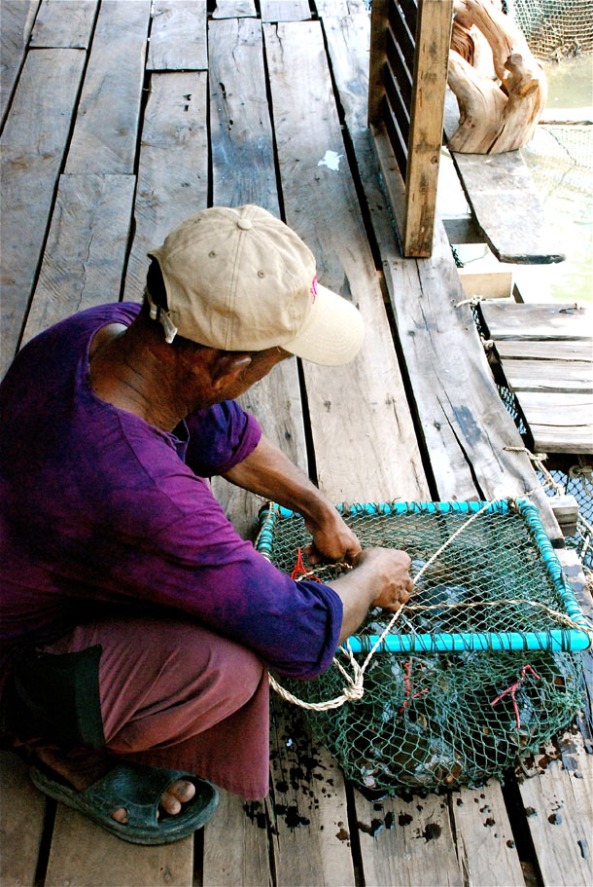

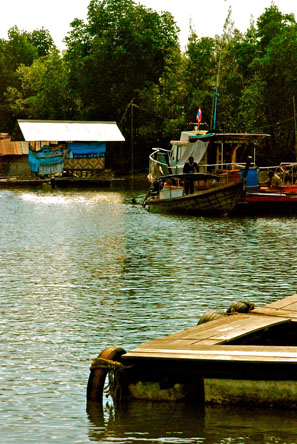
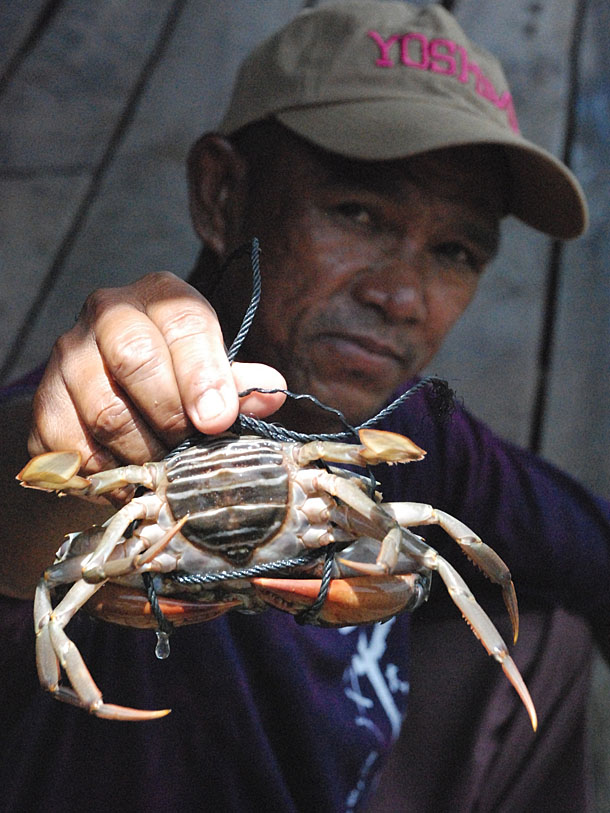
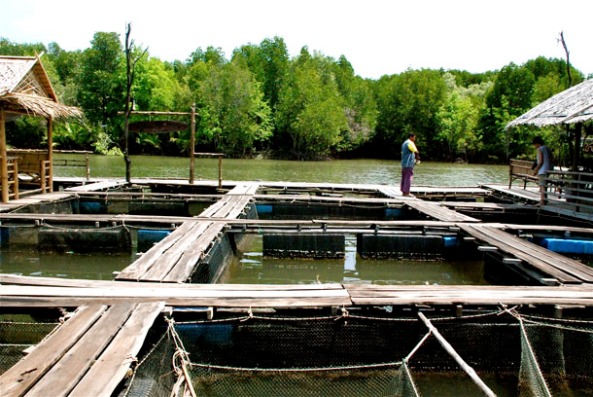
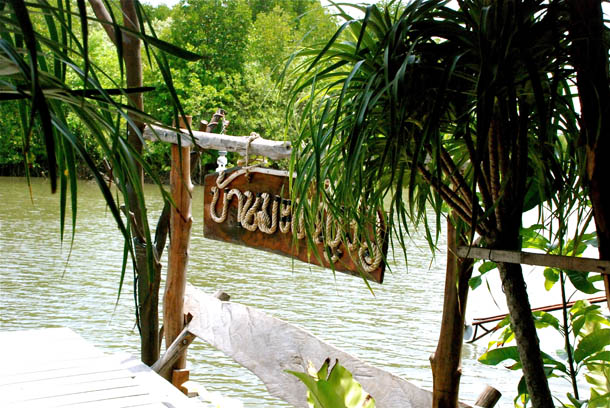
Baan Ma-Yhing written by curling a rope on a wooden plank, hangs by the canal. This is also the same place from where we set off for Kayaking the next day. Humidity soars on the day we visit the restaurant. The morning had been jampacked with a learning on Shallow water fishing and Shell fish hunting – just a few of the activities that we have partaken in during our stay in Koh Klang. My earlier post recalls the island life of Koh Klang, pictorially {Koh Klang in Krabi, Thailand | A Photo Essay of An Island Life}. As we settle down in the wooden benches, the restaurant staff promptly brings in the portable standing fan and focuses it towards us. Ice buckets reach the table. This is a major subject of controversy – to have them or not to have them? As mentioned in an earlier post, many suggest that one should only take ice if it is one of the round, cylinder type cubes that has a hole in them as these type of ice cubes are supposedly commercially produced in hygienic conditions. Whatever it is, I think it is the heat and the humidity that makes one forget the logistics and ask for ice, whether it’s in a restaurant or while ordering a drink off a street vendor. Ao nam keng?/Do you want ice? I don’t remember saying Mai ao nam keng/No, I don’t in my entire stay in Thailand. It only takes a while before you get addicted to the ice itself!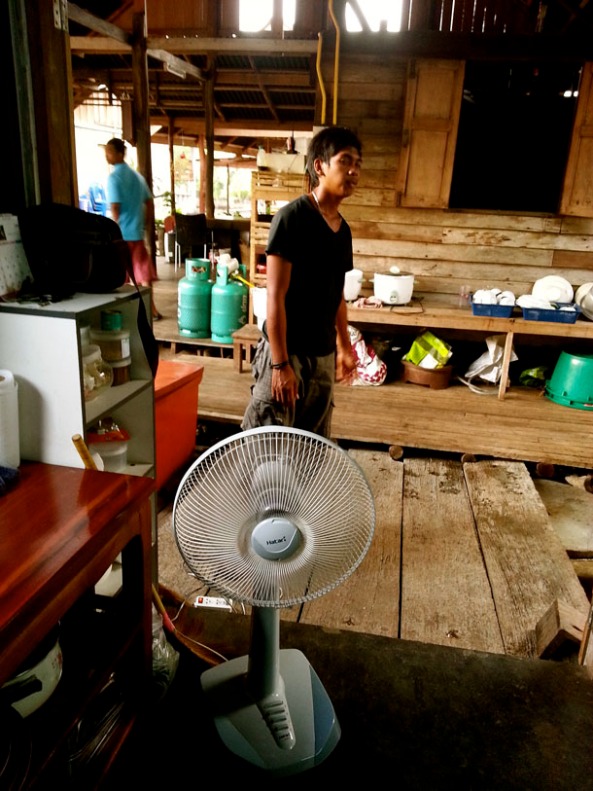

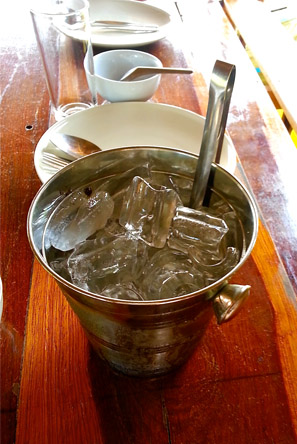
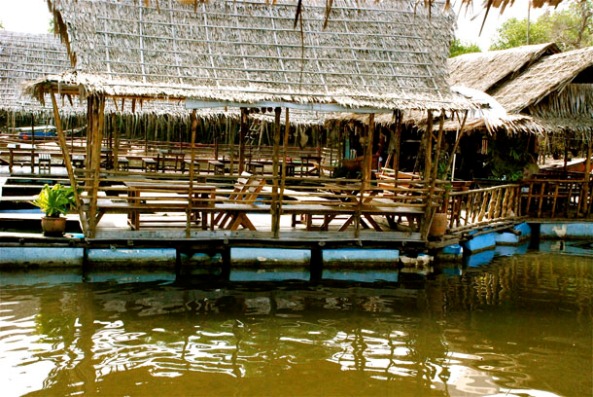
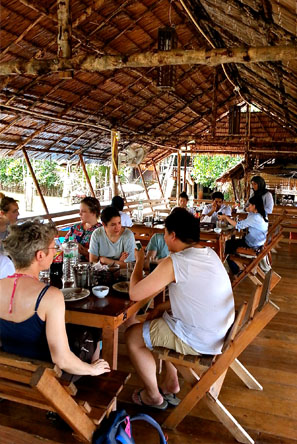
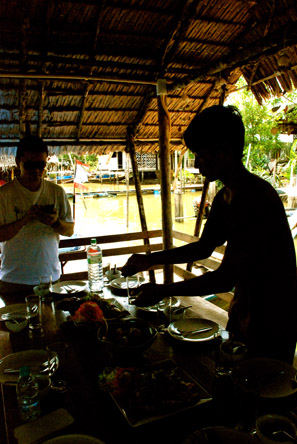
The Thai way of eating – all together, at the same time!
As we spend more and more time in Thailand, I realise – whether it’s a small restaurant or a big one, all the food that has been ordered is served at the same time to all tables. There’s no concept of Starters or Main course. And cooking starts once the guests pour into the restaurant so that food can be served freshly cooked. But not necessarily hot. This is because they’ll cook everything and serve only when the last dish has been cooked. The Thai people like to mix their food while they eat. One spoon of soup probably gets mixed up with a munch of crunchy starters, only to be wrapped up in noodles and then gets slurped in. I also asked the my co-diners, specially the locals who were sitting at the same table as me, whether it is the usual thing to cook so many items for regular meals at home. It seems that the food we ate is not spectacularly different from what they ate at home. The more dishes on the table, the happier they are. And the number of dishes increase as the number of family members increase. As I came back to Baan Ma-Yhing in the evening for a cooking class with Bao, the cook whose mum owns the restaurant, I realised that Thai cooking is elaborate in the numbers of spices and herbs that go into the dishes. But the cooking as such takes very little time (provided all the pastes have already been made before and the herbs and the vegetables have been chopped).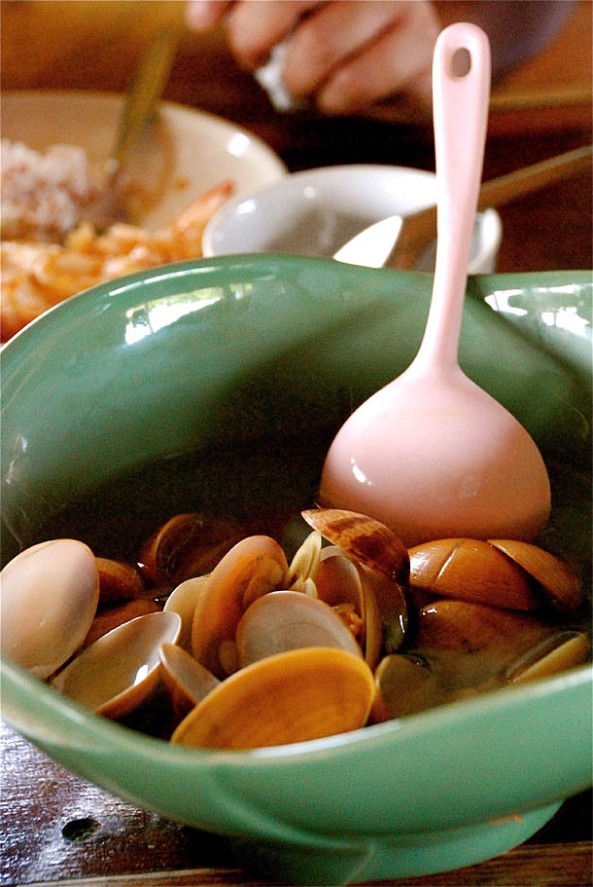
My first Thai food experience in Thailand had been brilliant {Ruen Mai Restaurant In Krabi | A Tantalising First Experience Of Thai Food {In Thailand, That is!}. A few days and some of these fishes became very familiar to me. I also feel in love with the above – the Clam soup with Lemongrass or the Hoi Talab Lai Tom Takrai. I’ve fallen in love with this dish – completely and absolutely. This is a very light clear broth with the clams boiled in. The strong flavour of ginger and lemongrass is very comforting. Even in Baan Ma-Yhing restaurant, the spread was very extensive. And I definitely got used to the Southern Thai style of cooking.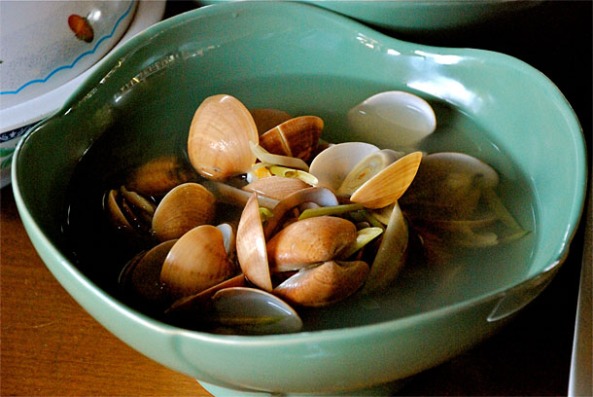
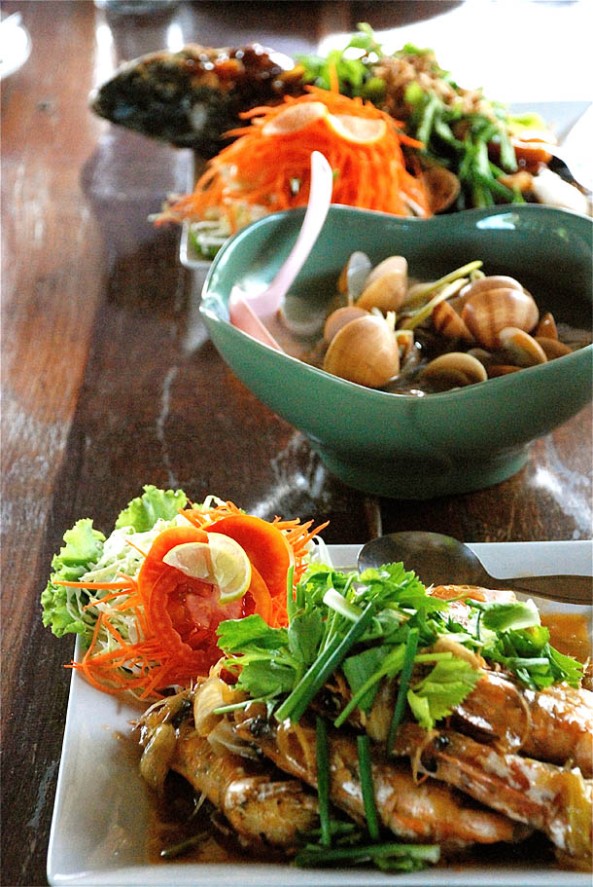
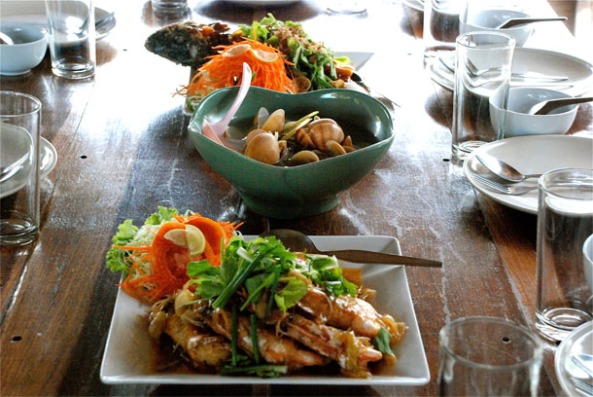
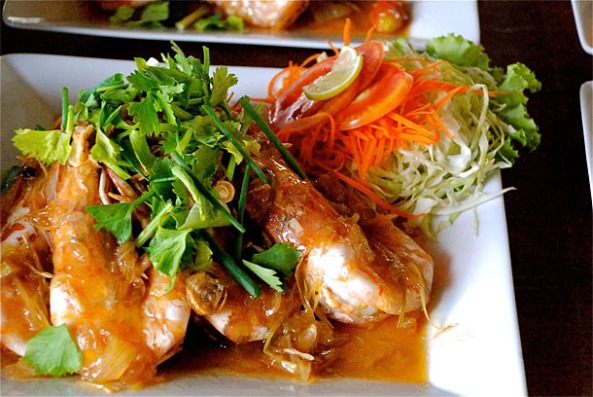
Goong Makham: Prawns in Tamarind Sauce (above and below) – this is also another dish that I was eating for the second time and I did come across many times in this trip and yes, you guessed it right – I ended up falling in love with. This is an easy preparation (yes, I’ve made this at home post-Thailand). Palm sugar is added into a wok over a low heat and stirred continuously until the palm sugar starts to melt and turn a little brown. Tamarind juice, fish sauce and pepper is added and stirred in for a few minutes until the sauce starts to thicken. Finally, the prawns are added and simmered for about 2 minutes and served with a garnish of fried onions and garlic… such a simple but tasty recipe that can be easily recreated at home.
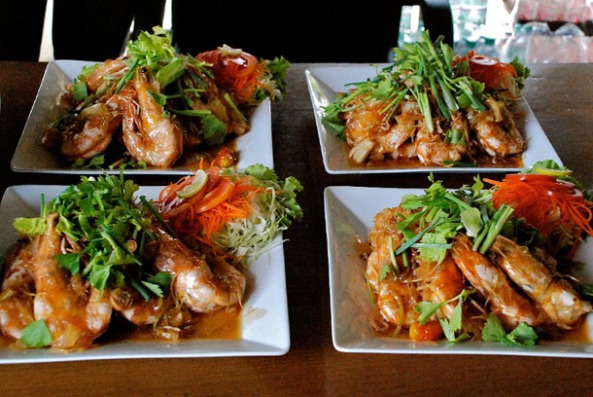

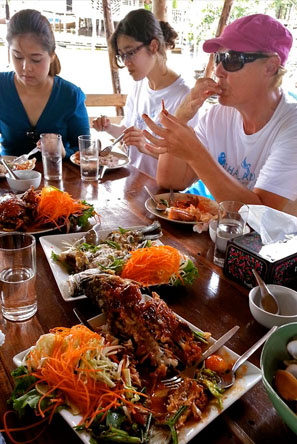
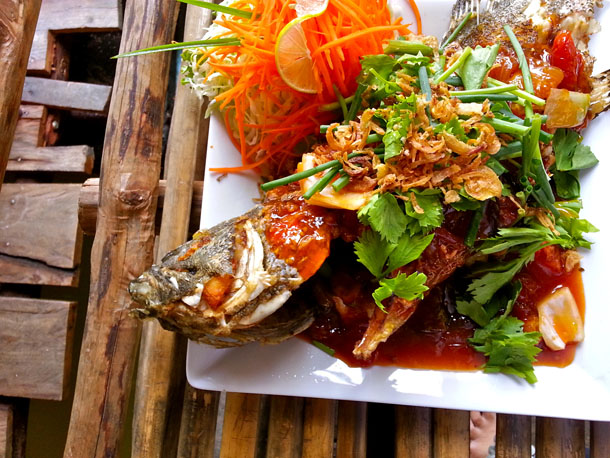
Pla Kao Rad Prik: Grouper topped with Chilli (above)… I learnt a variation of the same dish but made with the Baramundi later in the evening. These fish were also caught fresh infront of us before they were plopped into the pan. Another dish that was served to us was the Pla Krapong Nung Manao or the Snapper steamed with Lemon. This dish looks plain – the steamed fish but the sauce makes the taste buds go ballistic. It’s made with chopped green and red chillies only. This is really really hot! Bao, the cook has trained under a Chef working in one of the bigger hotel chains. He’s got a penchant for stylish presentation (as you can make out from the pictures – this is not a huge restaurant but the presentation is sophisticated and very stylish). The Crab stirred in Oregano (below) is his creation. Poo Pad Oregano, as is called, is not like the Singaporean Pepper crab though it looks very similar. The strong taste here comes purely from the Oregano. 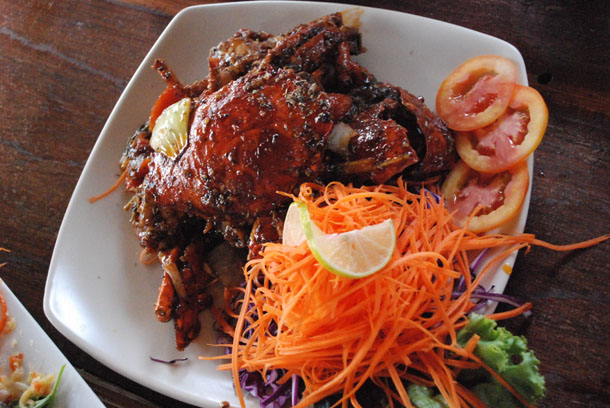
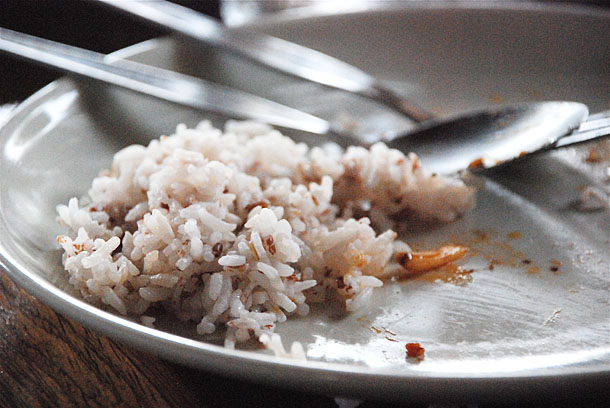
Sangyod Rice: Most of the population in the island are engaged in either coastal fishing or agriculture, specially in growing the organic Sang Yot or Sangyod rice. Originally growing in Pattalung, now there are only two places in Thailand where the Sangyod rice is produced and these are Koh Klang and Pattalung. The canals on the island of Koh Klang make it ideal for rice cultivation. Sangyod Rice is a purple coloured, high quality, fragrant organic rice, having a very high fibre content. Traditionally, Sangyod rice used to be cooked during special occasions or to usher in important guests. A bit of pounding (indigenous milling) leave us drained while the women who are engaged here, do such arduous pounding throughout the day – all with a pinch of smile! We were served Sangyod rice in one of our lunches (pic further down) – it tastes a bit salty because of the salt water in which the rice farms are sometimes submerged in. Do hop into my earlier post to see us toiling in the Rice farms (over dramatic, I know. But whatever sells!).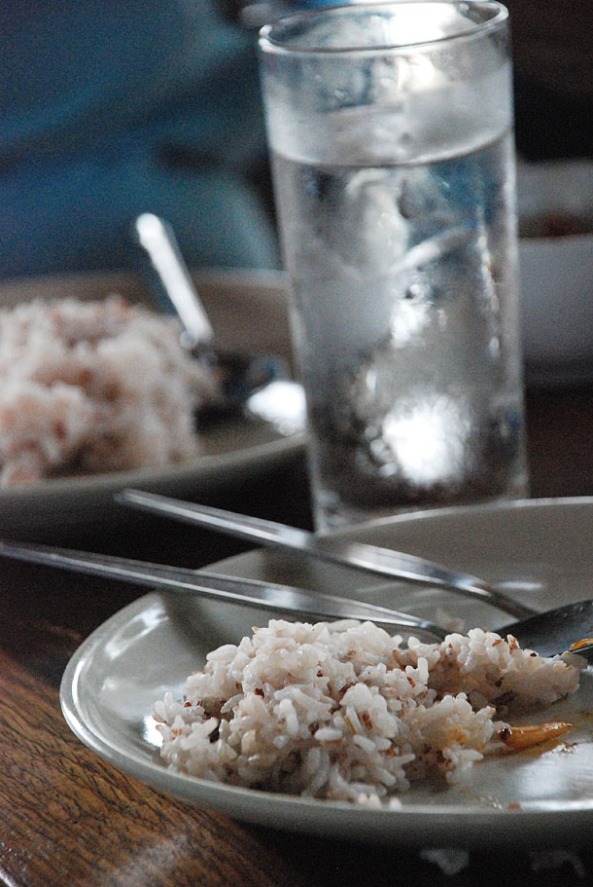
As in the Ruen Mai restaurant, here too the desserts consisted of only fresh fruits – mostly Watermelons and Pineapples. Delicious, fresh, chilled and generous amounts of these sliced fruits. Actually, It in Ruen Mai that we tasted a few more fruits like red Papaya, Mangoes and Wood Apple.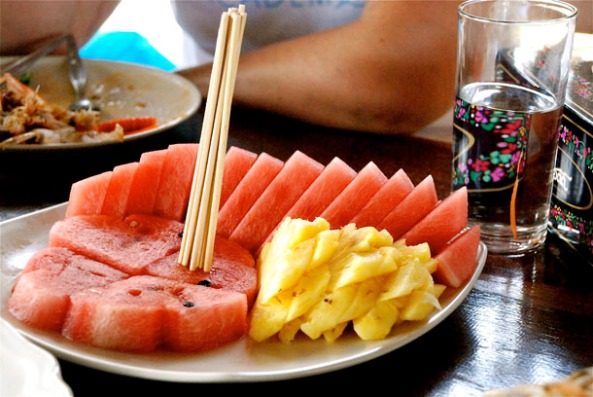
◊—————————————————————◊
Baan Ma-Yhing Restaurant
Seafood restaurant located in the fishermen’s village; Practices Halal
Location: 10 Moo 1, Klong Muang Krabi 81000, Thailand; Co-ordinates on Google map (below): 8.056278,98.932807; Email: Bdml111222@gmail.com
If you visit their Website, please remember that the Google translator literally translates the Thai into English! More on Koh Klang island from the web.
◊—————————————————————◊
Thai cooking lesson with Bao – fresh fish from the net to the frying pan!

Bao, the cook or the Chef of Baan Ma-Yhing became our tutor when Debbie (my #FoodieOnTour partner in this Thailand Academy trip and a fellow Fooderati blogger) and I came back later in the evening for our Thai cooking lesson. The lessons learnt:
1) The Red Thai Curry in Southern Thai Cuisine is not red in colour: This was one revelation that practically shocked me initially. The dishes in Southern Thailand had thick curries (mostly) that are poured on the top. Whole Turmeric or Kamin was grounded along with red chillies, thereby diluting the red colour of the Thai red curry. A bit of study into the Southern Thai curry reveals that there is a prevalence of coconut milk and fresh turmeric in most dishes here, as compared to other regions.
2) Oil is not put into the Wok first to make the Thai Curry: The curry is made as the Thai pastes are mixed into the Coconut milk as it boils in the Wok while the Chilli Oil (below right) is poured into it once the paste cooks itself in the Curry and the Curry itself has been thickened.
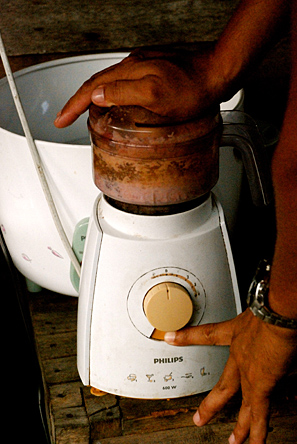
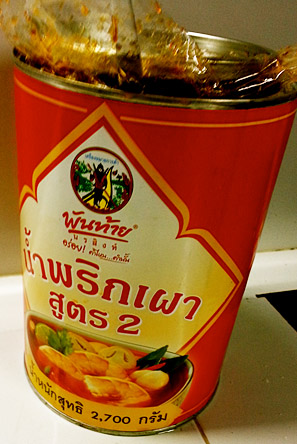

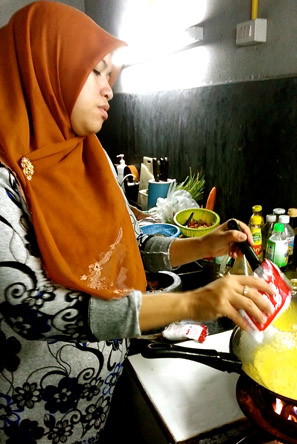
Bao’s sister, beautiful wife Sun (her name that is!), his 8 year old daughter – everybody joins in the cooking. The Baramundi fish that will be cooked is brought into the kitchen sink – alive! Before it goes into the Wok (below). Bao pours more than half litre of Palm Oil into the Wok for deep frying the Baramundi. What impresses us is that the oil left in the Wok would be recycled into lighting the stove. The Baramundi is deep fried and the Red Thai Curry that Bao’s wife makes (above left) is pored on top of the fried fish. Bao fine-tunes it again with pouring some thickened Coconut milk (third pic below).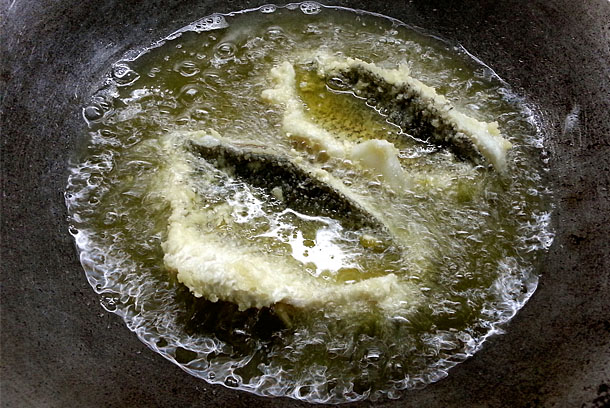
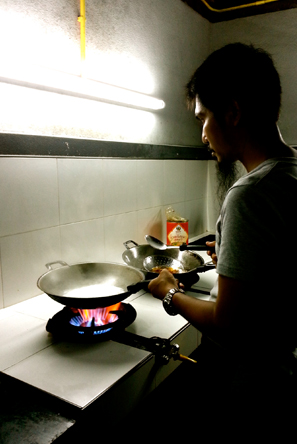

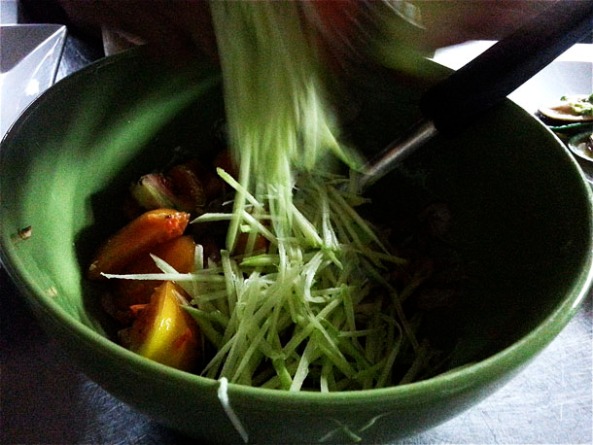
Chopping the salad for each dish takes some more time. As I’ve told you that Bao loves gorgeous presentation of food. He makes a Clam Salad with Tiger Prawns. He just puts the clams onto the pan and adds chopped fresh lemongrass, garlic and butter onto each clam. The clam cooks by itself, each clam carefully holding the delicious juice that come out of the mussels (below). Tiger Prawns are just placed on heated pans and is covered with a Wok turned upside down. No oil, no salt – the prawns gets cooked on its own. Bao presents them with tomatoes, chopped coriander leaves and the mussels, accompanied by a spicy dip. 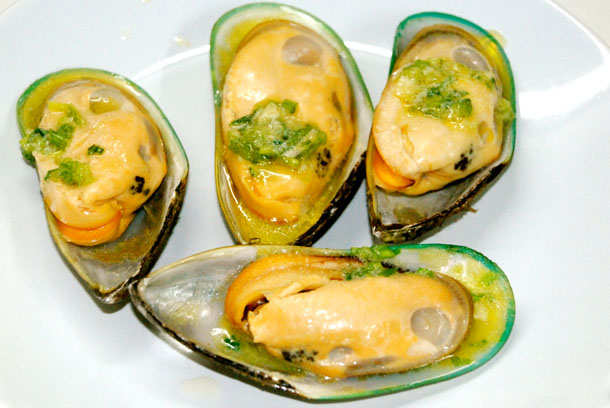
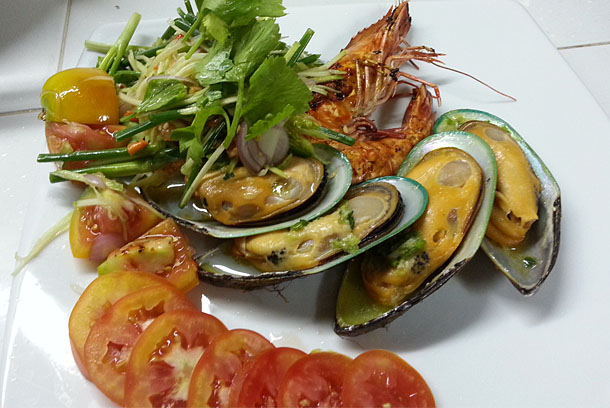
Another thing that he cooks is the Prawn cakes – very different from the ones we have tasted. He chops fresh chicken and prawns (uncooked) and minces them in the food processor. He adds chopped garlic, onions, lemongrass, spring onions and pepper into the mince. He rolls them into large pattice and puts a piece of Salted Egg Yolk (Pla Meuk Pad Kai Kem – salting eggs in brine is a way of preserving eggs in Thailand. The weather can be very hot and eggs could only be kept for a short time unless salted. As with many cultures, the Thai’s acquired a taste for the salted product, and created recipes around it {More here…} in each pattice and fries them slightly. Then he takes them out of the oil and cuts them into two and deep fries the pattice halves in oil. 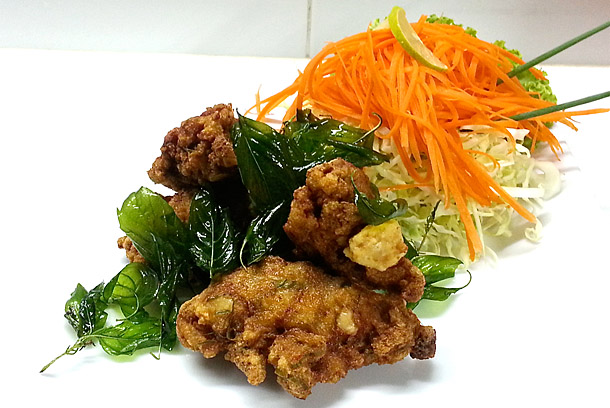
◊—————————————————————◊
Baramundi in Thai Red Curry
Category – Fish/Seafood; Cuisine type – Southern Thai
Following are the characteristics of all recipes doling out of our little hands, big hearth –
♥ Easy to cook
♥ Regular canned products off the shelf may be used (However, we advocate using fresh products)
♥ Goes well both as a regular or party dish
♥ Children can easily help in making the dish (My two little sous-chéfs are aged 8 and 3 years 4 years)
♥ And lastly, guaranteed to be tasty!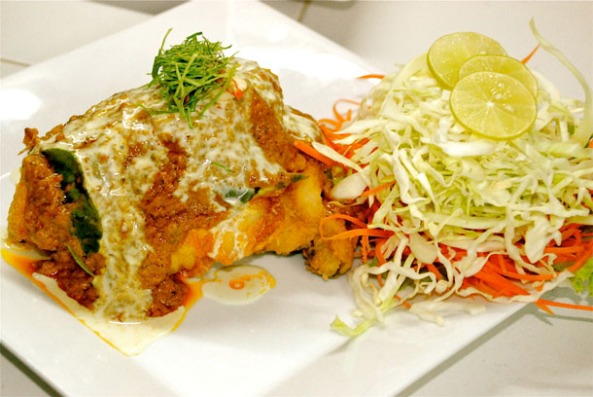
For the printable recipe →
Serves 4 persons
Preparation time – 45 mins maximum (Cooking time – 30min; Remaining time is for the preparation)
Ingredients
Barramundi fillets or any whole fish – deep fried in oil (Bao didn’t put any salt but I did put a bit of salt to the fish when I made the same recipe at home)
White Oil – 2 cups, for frying the fish
Thai Red Curry – 1 cupCoconut Milk – 1/2 cup, thickened to pour over the top
Basil Leaves – 20 pieces, deep fried in White Oil
Lemongrass – finely chopped, for garnish
Thai Kaffir Lime Leaves – for garnish
• Once the fish is fried, the Thai Red Curry is poured on top of it and the thickened Coconut Milk is added on it. It’s served with the fried Basil leaves on the sides and garnished with Kaffir Lime and chopped Lemongrass.
Thai Red Curry Paste or the Kaeng Phet
Ingredients
Shallot – 1 medium, chopped
Garlic – 4 cloves
Galangal or Thai Ginger – 1 inch in size, skin peeled
Red Chillies – 10 medium sized
Lemongrass – 1 fresh stalk, chopped finely
Kamin or Whole Turmeric – 1 inch in size, skin peeled
White Pepper – 10 whole pieces
Nam Pla or Fish Sauce – 2 tbsp (For vegetarians, you could substitute the Fish Sauce and the Shrimp Paste with 2 tbsp of dark Soy Sauce)
Kapi or Shrimp paste – 1 tbsp*
Thai Red Chilies – to taste (optional)
Kaffir Lime Leaves – 4 to 5 or Lime peel
Sugar – 1tsp
Method of Preparation
Grind all the ingredients with a pestle and mortar or in a food processor. Add 2 tbsp of Coconut Milk in order to loosen the paste, if required.
*(In Thailand Kapi or the Shrimp Paste is an essential ingredient and is used in Thai dips, sauces, curries and paste. Very popular in Thailand is Nam Phrik Kapi, a spicy condiment made with fresh shrimp paste and most often eaten together with fried Pla Thu/Short mackerel and fried, steamed or raw vegetables. In Southern Thailand there are three types of shrimp paste: one made only from shrimp, one containing a mixture of shrimp and fish ingredients, and another paste that is sweet. More here)
Though Banu didn’t use, but many standard Thai Red curry pastes call in for Kaffir lime or Thai lime peel, Coriander root, Coriander seeds, Cumin seeds along with additives such as Thai eggplant, Bamboo shoots, Bai horapha or Thai basil leaves. Also, there are lot of regional differences in Thai cooking. Whereas in the North, in the Chian Mai region they don’t use ground Turmeric in the Red Curry, in South Thailand, whole Turmeric is ground along with the red Chillies.
◊—————————————————————◊
Islanda Eco Village Resort
Thai Village styled Eco Resort; On Koh Klang, Krabi
Islanda Eco Village Resort is an eco-resort, with the accommodation originally styled after Thai village huts (conical structures) that wouldn’t require any air conditioning. Submerged mangroves, loud chirping of birds, the lazy sunset over the Andaman seas and the water seeping through the fishing traps and bamboo fences into the resort grounds – the resort blends into the entire island, which practices sustainable tourism. In the recent years, we have been trying to travel responsibly and checking into the Islanda Eco Village Resort just adds to the gradually growing list of the Eco Resorts that we’ve visited so far. All fresh produce that is required in the Resort’s kitchen, is bought from the local markets on the island, (a tick mark on my current favourite topic of Locavorism) and fish is brought from the local fishermen. This is the only resort in the island and it completely blends into the surrounding environment without disrupting the island’s unique eco-system.
Tel No: 083-636 7887; Location: Moo 3 T. Klong Pra-Song (Koh Klang) A. Maung Krabi, Nong Thale, Mueang Krabi, Krabi 81000, Thailand
Islanda Eco Village Resort: Website; Facebook Page; Instagram
◊—————————————————————◊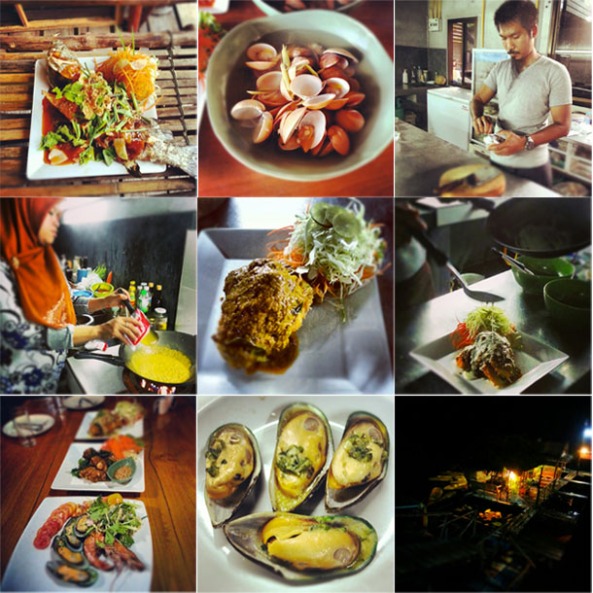
Debbie has written beautifully about our Koh Klang island experience. All throughout our trip we realised how much of a social traveller we had become. I had to Tweet, Instagram (above) and post on my Facebook Page and although I was travelling without my family leaving behind the Z-Sisters, I was not travelling alone. I was constantly in touch with my readers and friends through LIVE interaction over social media. This perhaps is the new phenomenon in travelling as is evident by the super amazing travel series of the two Emirati brothers in the Peeta Planet. I love these two guys. They are dare devils and hilarious and are out to something that no one has done – see the world the way their followers want them to see. Although my travel decisions might not be dependent on those who are following me on social media, but I have been sharing my stories and taking many cues from suggestions left behind. I started blogging because I wanted to share my stories. While previously I could share my travel and culinary stories only when I blogged about them, now I share them LIVE while write my blogposts in detail much later. What do you have to say about this kind of social travelling? Would you rather make your own travel plans or will you fly to a place on the basis of a comment left on your Social media page?
Unblogging it all… Ishita
Disclaimer: The Thailand Academy trip was an invite from the Tourism Authorities of Thailand Middle East and Aviareps Group. However, the opinions stated here are my own and are independent. I do hope you enjoy reading the posts with lot of visuals. Please do not use any material from this post. You can see more pictures of my travel and food journey here.
◊—————————————————————◊
My other Thailand posts:
- Ruen Mai Restaurant In Krabi | A Tantalising First Experience Of Thai Food {In Thailand, That is!}
- Koh Klang in Krabi, Thailand | A Photo Essay of An Island Life
Other posts on my Oriental Journey:
- Singapore At Night
- Eating Out Is A National Pastime | Singapore
- Bikol Express & The Romanticism Of The Mayon Volcano
- Pancit – Palabok, Bihon, Canton | On A Filipino Food Trail
Posts from other members who were in the trip:
- Ein Dorf am Meer: Islanda Eco Village Resort, Krabi, Thailand «Escribo»
- Amazing Thailand – Dubai to Koh Klang – a Krabi experience «coffeecakesandrunning.me»
- Koh Klang Local Village Life «coffeecakesandrunning.me»
- Kayaking & Spa Day in Krabi «coffeecakesandrunning.me»


Your attention to detail is very captivating !
LikeLike
Sayan, I’m all smiles now:)
LikeLike
Love this article Ishita, I feel that I’m back in Koh Klang savouring every mouthful of the great food we had there 🙂
LikeLike
Thank you so much. Did you click any pictures of the veg food that was being served to us. Feel the need to do a veg post all the more. Have told Claudia too:)
LikeLike
Hello Namesake, thanks for the ethnographic detail 🙂 I also loved the way the Green Coconut is served 🙂 quite innovative must say … thanks for bringing thai food to our screens and kitchens 🙂 Much love and belated subho noboborsho:)
LikeLike
Thank you so much and Shubho Noboborsho to you as well! When a place is so inspiring, the post is bound to reflect a bit if it… glad that I could do a bit of justice to it:)
LikeLike
Blimey what a post! I just had dinner yet you managed to make my mouth water with a passion! Gorgeous photography, I am putting this place on my wish list!
LikeLike
Thank you Francine… maybe I should direct my post directly to your wishlist and you should do the same with your ‘slow’ posts! BTW, Debbie and I have learnt to cook this… not letting our tutor down! More posts to come… would love your feedback:)
LikeLike
Pingback: Kayaking & Spa Day in Krabi | CoffeeCakesAndRunning
Pingback: Songkran Splash At Westin And A Dinner At Sukhothai | Celebrating Festivals in Dubai – Episode 2 |
Pingback: Baisakhi Celebration in Patiala and Options By Sanjeev Kapoor | Celebrating Festivals in Dubai – Episode 3 |
Pingback: Poila Baishakh with Shiraz | Celebrating Festivals in Dubai – Episode 4 |
Pingback: Thai Red Curry Paste & Thai Red Curry Cream Dory dinner | CoffeeCakesAndRunning
Pingback: {New Post} Kotung Restaurant in Krabi Town | A Taste of Thai Chinese |
Pingback: Kayaking, Caves, Krabi Sightseeing… And Finally A Thai Spa! |
Pingback: Hong Island… Where I Finally Met God! |
Pingback: Chef’s Table At Thiptara | And A Romantic Dinner Invite From The Palace Downtown! |
All I can say is WOW! Amazing food! Freshly catch seafood, cooked and served to you is a rarity nowadays. Wow, you had amazing time in Thailand!
LikeLike
A great learning for sure:)
LikeLike
Yes, we did have an amazing time Mary. Hoping that it comes through my posts 🙂
LikeLike
The pictures are really good. It speaks for itself.
LikeLike
Thanks Alister!
LikeLike
thai red curry..one of my favourite dishes
LikeLike
Thanks mel:)
LikeLike
I constantly spent my half an hour to read
this webpage’s content everyday along with a mug of coffee.
LikeLike
Thank you so much! It feels great knowing this. Look forward to you dropping in again Myles:)
LikeLike
Touched by this warm feedback Myles:)
LikeLike
Pingback: Ginger Lotus Sea Bass | Recipe From Blue Jade @RitzCarlton |
Pingback: Blog Turns 2 | A Chance To Meet Masterchef Sanjeev Kapoor For 2 Lucky Readers! |
Pingback: The Tastiest Fast Feasts On Earth | Chowzter Awards 2014 Curated By Food Bloggers |
Pingback: The Golden Dishes of Dubai | Countdown To 2015 | IshitaUnblogged
Pingback: Thailand | Krabi Kayaking & Spa
Pingback: Recipe | Thai Red Curry Paste
Pingback: IshitaUnblogged - Shorshe Bata Maach – Mustard Salmon In This Case | A Detour From Thailand To Wish Shubho Noboborsho!
Pingback: Day 15 Thailand, Krabi – Traveljunkies
Pingback: Travel Blog: Krabi, Thailand (Part 2) – relish
Pingback: Thailand Unveiled: Krabi Naga Fest 2020 — Every World Heritage Site
Pingback: Thai Papaya Salad Recipe – Also reminiscing the Floating Market in Global Village – IshitaUnblogged